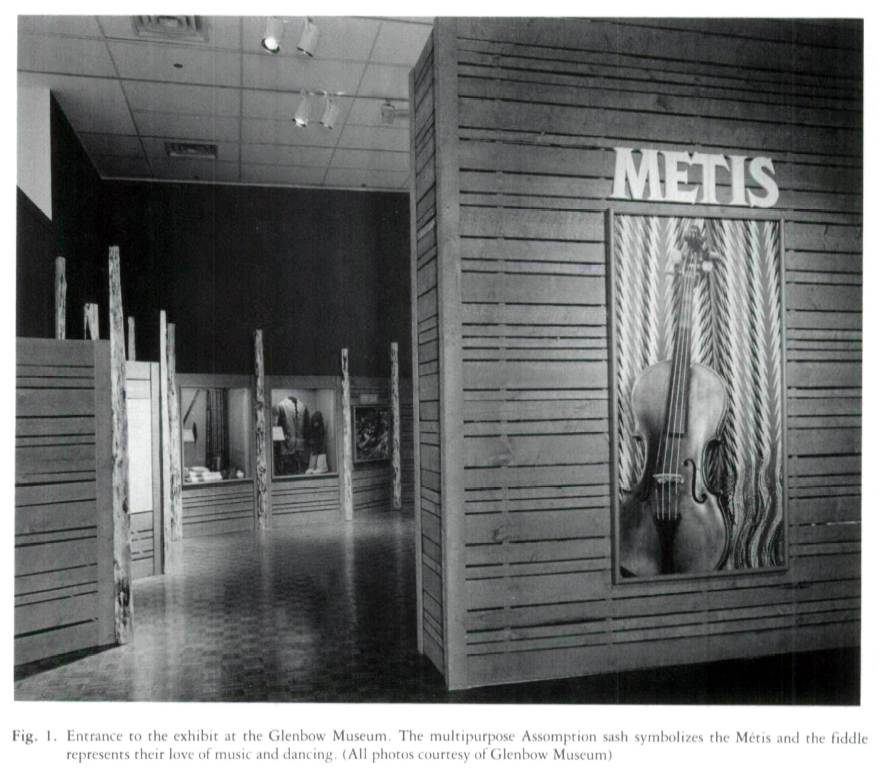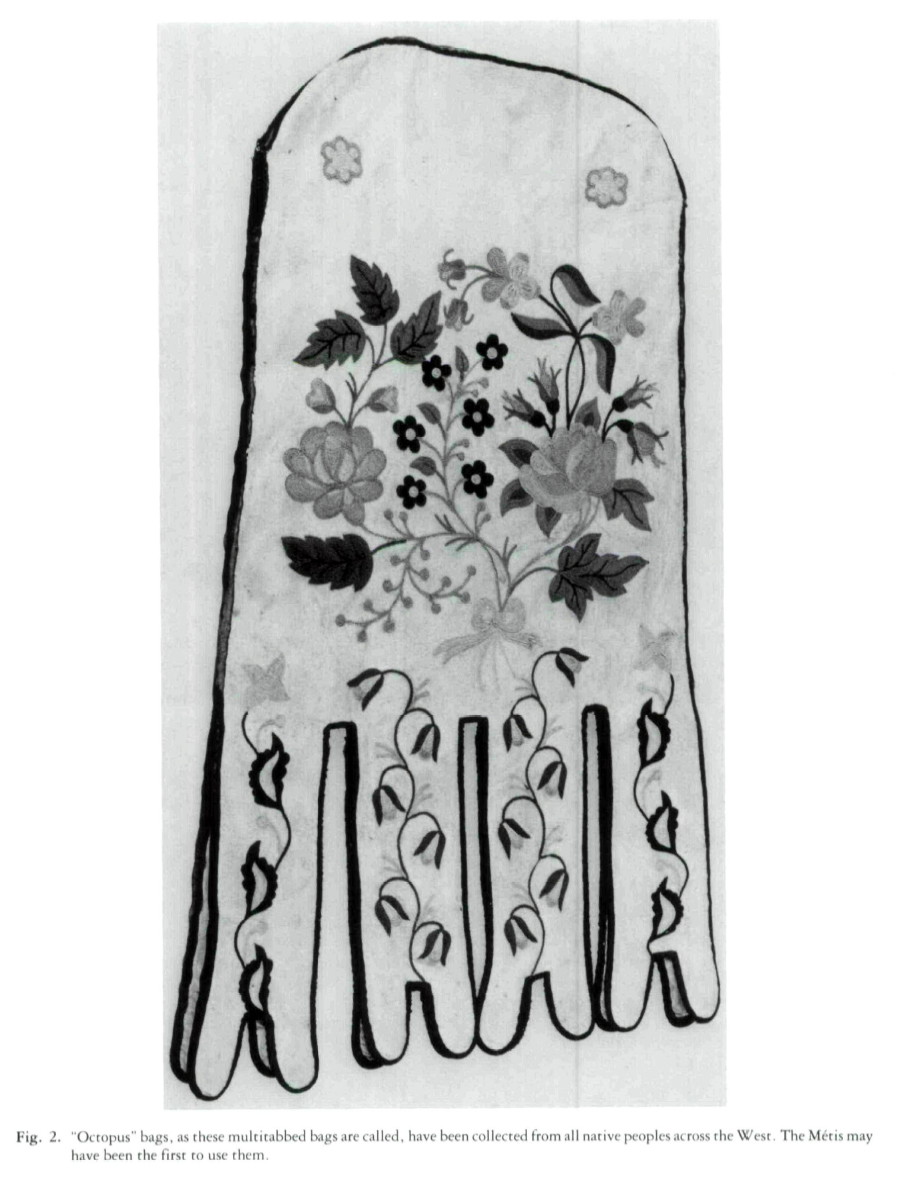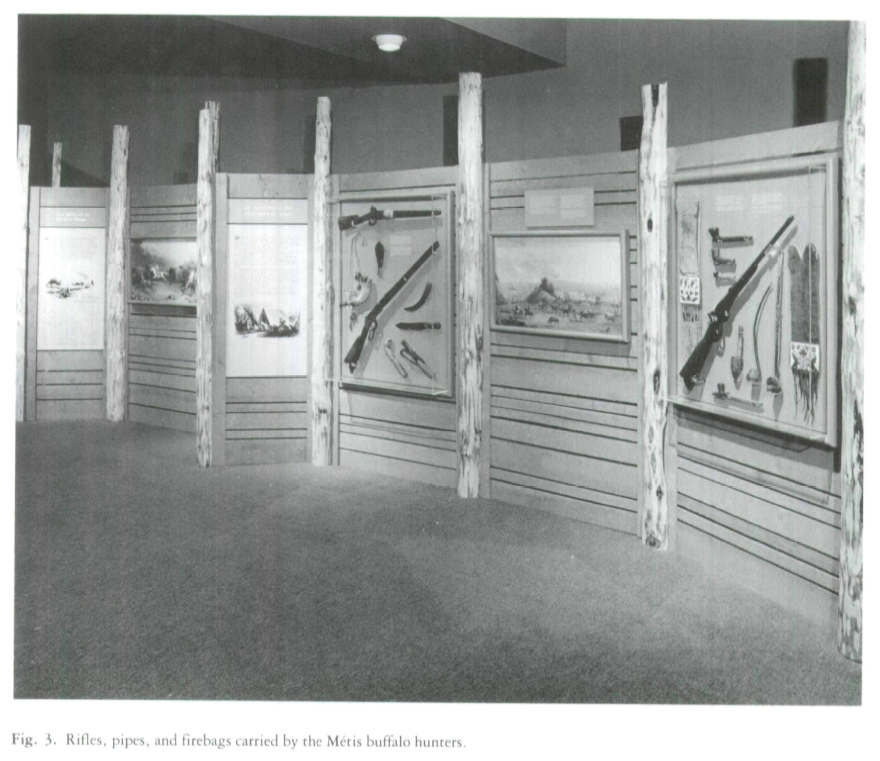Reviews / Comptes rendus
Glenbow Museum, "Metis"
1 The creation of a new people, the Métis, is one of the most dynamic and significant aspects of Canada's past. These "sons and daughters of the country" built numerous small communities from the Great Lakes to the Mackenzie Delta and manned the fleets of York boats of Lake Winnipeg, the portages of the woodlands, and the buffalo hunt of the plains. Like the Cree and Ojibwa from whom they were descended, they made the rapid transition from the forest to the plains and from the position of an autonomous political force to that of an out-cast and dependent people with the "mark of Cain upon them."
2 Their resistance to the transfer of the Northwest in 1870 brought Manitoba, a new province, into Confederation. Their rebellion in 1885 was a significant watershed in Canadian history, which, it used to said, placed Quebec [almost] permanently into the hands of the Liberal party. The irony of Trudeau (who had so vehemently opposed aboriginal rights) enshrining Métis rights in the 1982 Constitution is matched only by the prospect of the inheritors of Sir J. A. Macdonald fulfilling such promises. Riel was hanged and the Métis defeated in 1885, but in the late twentieth century the presence of the "new people" is not only evident in the daily reality of Western Canada but is also part of the nation's political agenda.
3 One century later there has been a veritable explosion of Riel celebrations — conferences, books, articles, statues and commemorative services. Much of this has been myth-building and has reinforced the impression that the Métis were all French-speaking buffalo hunters, devout Catholics following the dreams of a charismatic leader and that they, like Riel himself, disappeared from the national consciousness after 1885.
4 In this context the Glenbow's "Metis" travelling exhibit makes three major contributions to the emergence of a new approach to Métis studies. First by presenting the material culture of the Métis, a more useful holistic version of the mixed bloods of the northern plains is offered. The decorative traditions of both Indian and European are evident in the work of Métis women, while the tools and artifacts of the men are consistent with the working life they shared with Indian and Orkneyman until the mid-nineteenth century.
5 Secondly, the emphasis in this exhibit on the twentieth-century experience of Métis in Alberta will be an important corrective to the commonly held assumptions of most Canadians. Service in Canada's armed forces, political organization and the inescapable poverty of most Alberta communities are a far cry from the dramatic images of the buffalo hunters of the plains so dominant in western mythology.
6 Finally, in intellectual terms, this was an exhibit that depended on the object, the audio-visual presentation and the relict, and was thus available to a very wide audience. In its three-month sojourn at the Museum of Man and Nature in Winnipeg it brought in more than ten thousand visitors, some from distant communities who would not otherwise have been part of the celebrations of 1985.
7 The artifacts travelled well, required little local assistance in unpacking and mounting and brought only minor security problems. The exhibit was enriched by a lively local educational programme, ranging from book launchings to fiddle concerts, with auxiliary exhibits from the collections of the Musée St. Boniface and the Manitoba Museum. The accompanying book Metis by curator Julia D. Harrison (Vancouver: Douglas and McIntyre, 1985), though unfortunately not a catalogue raisonnée, is sensitively written, well illustrated, and in its post-1920 chapters does make a contribution to Métis studies. This was, in short, a good regional exhibit, which will effectively convey aspects of Métis life and history to the rest of the country. It is, at one level, the fruits of that Utopian national museum policy of the 1970s which sought to meet the challenges of distance and particularism in the national cultural life.
8 Should we, in the 1980s, raise our expectations of travelling exhibits and particularly those from major institutions such as the Glenbow? We might require, for instance, that such exhibits represent the most recent scholarship. It was a disappointment here that "Metis" did not use the work of scholars such as Jacqueline Peterson on the early nineteenth-century Métis origins in the Great Lakes region.
 Display large image of Figure 1
Display large image of Figure 19 Should we expect curators to enter the scholarly debate, to express a clear cut point of view rather than take us on another descriptive journey? The Métis have inspired an intense historical discussion from the "half savage" version of W.L. Morton or G.F.G. Stanley to the religious authoritarianism depicted by Tom Flanagan or the "state of siege" between French and English of Frits Pannekoek. But the intellectual vigour of that debate is lost in the translation to museum exhibit.
10 Might we not also expect that in the late twentieth century we should be offered an international setting for this part of Canada's past' There is nothing unique about the emergence of mixed blood peoples particularly as part of the imperial experience of the nineteenth century. But there is a great deal that is unusual and significant, in a world sense, in the creation, experience, and survival of Canada's Métis. The absence of such a context clouds our perspective of both Canada and the Métis.
11 And finally, what of the artifacts themselves — those medicine bundles of museological practice? Here the curator faced a problem presented by similar cultures relatively poor in material terms. In addition, the significance of the Métis object lies in its evident combining of elements of both European and Indian cultures, often in the shadow of more spectacular pieces of both contributing cultures. The narrow-waisted European coat, tailored in skin and embroidered in silk or the similar "mixed media" Glengarry cap are some of the all too few object which could stand alone and convey a striking and immediate sense of "Métis." Some artifacts were marred by obscurely worded labels: clothing, for example, which "tailed to follow the functional logic of the prototype." Others such as the military pay books, the scrip certificates, or the fragments of the rope reputed to have hanged Riel may have emotive power but are, in all senses, the artifacts of the dominant society. To those from the "connoisseur school" of curatorship, the travelling section of the exhibit, at least, may be a little disappointing.
 Display large image of Figure 2
Display large image of Figure 2 Display large image of Figure 3
Display large image of Figure 312 For the "ideological school" of curators, those whose curio cabinets are merely a file of illustrations, this exhibit may be more satisfying. The extensive use of music, photographs and video material is clearly necessary to carry the descriptive approach the curator has chosen. There is, in fact, a good case to be made for extending the austere, political themes of the exhibit with more of such auxiliary material to include the humour and especially the poetry and literature of modern Métis writers such as Emma LaRocque, Maria Campbell or Beatrice Culleton.
13 Louis Riel is remarkable by his absence from this exhibit. But the rebellion, the cataclysm which divides the Métis from Canada, is always present. The fragment from the rope that hanged Riel, like the true cross itself, is the alpha and omega of the visitor's journey. The meaning of the rope is powerful. The charge in 1885 was treason and the verdict was guilty. The Métis, collectively, face not only the conditions of racism and poverty described in this exhibit, but also, in a historical sense, the accusation of being the enemy within.